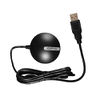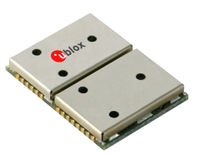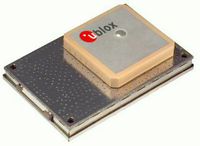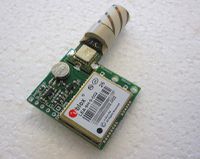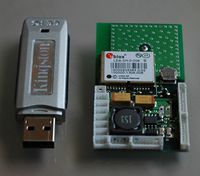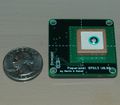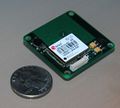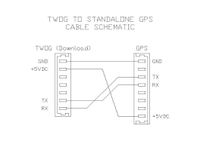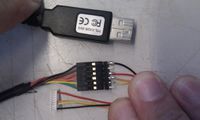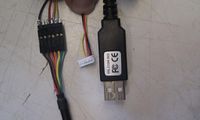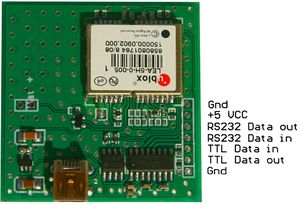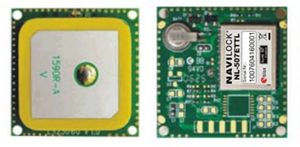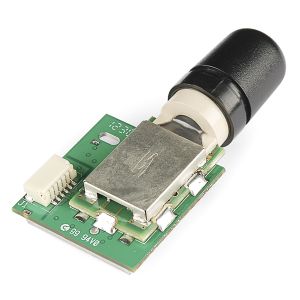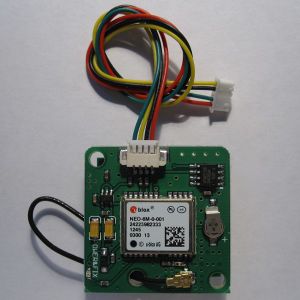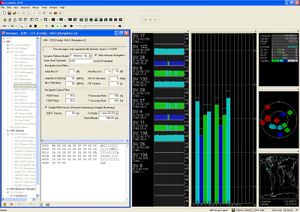Difference between revisions of "Sensors/GPS"
| Line 1: | Line 1: | ||
<categorytree style="float:right; clear:right; margin-left:1ex; border: 1px solid gray; padding: 0.7ex;" mode=pages>Sensors</categorytree> | <categorytree style="float:right; clear:right; margin-left:1ex; border: 1px solid gray; padding: 0.7ex;" mode=pages>Sensors</categorytree> | ||
<div style="float:left; clear:left; margin-right:2ex; padding: 0.7ex;">__TOC__</div> | <div style="float:left; clear:left; margin-right:2ex; padding: 0.7ex;">__TOC__</div> | ||
=GPS Receivers= | |||
An overview of GPS receivers used icw paparazzi. The list is by far not complete. A lot more devices will work flawlessly with Paparazzi. If you have a GPS receiver you used with Paparazzi and is not listed here, it would be great if you could add addtional information on this page. | |||
==Swiftnav Piksi== | |||
A very special receiver is the OpenSource (almost all...) Swiftnav Piksi GPS receiver. How to use this device with Paparazzi is described on the a specific page | |||
[[Image:Piksi_GPS_back.jpg|100px|thumb|left|Swiftnav Piksi]] | |||
==LS20031 GPS Receiver== | |||
[[Image:ls20031.jpg|100px|thumb|left|LS20031]] | |||
Sparkfun sells the LS20031 GPS module which uses NMEA (Paparazzi support for NMEA is BETA right now.) This Locosys GPS module supports WAAS (U.S. DGPS), EGNOS (EU DGPS), and MSAS (Japanese DGPS). | |||
More information on configuring the GPS via PMTK can be found [http://dallasmakerspace.org/wiki/LS20031_GPS here] | |||
<br style="clear:both;" /> | |||
==Globalsat BU 353== | |||
[[Image:BU-353_gps_receiver.jpg|thumb|left|100px|BU-353 GPS receiver]] | |||
USB US Globalsat GPS-Mouse compatile with the Parrot AR.Drone 2.0.<br/> | |||
Compatible with Windows, Mac and Linux.<br/> | |||
More information at the [[GPS/BU_353]] site. | |||
<br style="clear:both;" /> | |||
==uBlox== | |||
[[Image:U-blox_color_warm_60.gif|100px]] | [[Image:U-blox_color_warm_60.gif|100px]] | ||
[http://www.u-blox.com uBlox is a Swiss technology company] which develops and delivers very good positioning modules. It produces the recommended GPS modules for use with Paparazzi autopilots from the popular brand of receivers. | |||
Why uBlox: | |||
*Low cost [[Sensors/GPS#u-blox_NEO-6M|NEO6-M]]) | |||
*Low cost | |||
*Small size | *Small size | ||
*Excellent performance | *Excellent performance | ||
* | *Up to 10Hz update rate | ||
* | *Large amount of different modules | ||
*5V tolerant UART | *5V tolerant UART | ||
| Line 24: | Line 50: | ||
'''Note:''' The proprietary UBX protocol is used as it offers more information and efficiency than the universal NMEA protocol. The protocol is parsed in <tt>sw/airborne/subsystems/gps/gps_ubx.c</tt>. | '''Note:''' The proprietary UBX protocol is used as it offers more information and efficiency than the universal NMEA protocol. The protocol is parsed in <tt>sw/airborne/subsystems/gps/gps_ubx.c</tt>. | ||
===u-Blox LEA Series Receivers=== | ===u-Blox LEA Series Receivers=== | ||
| Line 45: | Line 69: | ||
<br style="clear:both"> | <br style="clear:both"> | ||
===Paparazzi Stand-alone GPS Receivers=== | ===Paparazzi Stand-alone uBlox GPS Receivers=== | ||
<gallery> | <gallery> | ||
| Line 62: | Line 86: | ||
</p> | </p> | ||
==== Wiring Diagram ==== | ====Wiring Diagram==== | ||
{|align = none | {|align = none | ||
| Line 97: | Line 121: | ||
[[Image:GS407.jpg|thumb|left|SPK GS407]] | [[Image:GS407.jpg|thumb|left|SPK GS407]] | ||
[https://www.sparkfun.com/products/11466 This] is the model Sparkfun recommends as a replacement for the old GS406. It's essentially the same, but uses the newer 6-series receiver, and is not using a ribbon cable as an interface. | [https://www.sparkfun.com/products/11466 This] is the model Sparkfun recommends as a replacement for the old GS406. It's essentially the same, but uses the newer 6-series receiver, and is not using a ribbon cable as an interface. It uses [http://www.sarantel.com/products/sl1206 Sarantels] SL1206 active antenna. | ||
It's recommended to buy [https://www.sparkfun.com/products/574 This extension cable] to use with it | It's recommended to buy [https://www.sparkfun.com/products/574 This extension cable] to use with it. | ||
<br style="clear:both;"/> | <br style="clear:both;"/> | ||
| Line 121: | Line 145: | ||
<br style="clear:both;" /> | <br style="clear:both;" /> | ||
=== | ===uBlox GPS configuration=== | ||
== | ====using U-Center==== | ||
[[Image:U-center_screencap.jpg|thumb|u-center configuration software]] | [[Image:U-center_screencap.jpg|thumb|u-center configuration software]] | ||
| Line 154: | Line 164: | ||
ln -s /dev/ttyUSB0 ~/.wine/dosdevices/com1 | ln -s /dev/ttyUSB0 ~/.wine/dosdevices/com1 | ||
This command will create the symbolic link from ttyUSB0 to COM1. See Info on Wine for "dosdevices" setup. Just download the u-setup.exe and run it with Wine, follow prompts. This has been tested with Ubuntu7.10 and Ubuntu 8.04 so far. | This command will create the symbolic link from ttyUSB0 to COM1. See Info on Wine for "dosdevices" setup. Just download the u-setup.exe and run it with Wine, follow prompts. This has been tested with Ubuntu7.10 and Ubuntu 8.04 so far. | ||
| Line 164: | Line 175: | ||
<br style="clear:both"> | <br style="clear:both"> | ||
===Uploading the Configuration File=== | ====Uploading the Configuration File==== | ||
Download the appropriate configuration file below and use u-center to load in onto your receiver. Under the ''Tools'' menu, choose ''GPS configuration''. Be sure the box 'Store configuration into BBR/Flash' is checked and hit the button ''File>>GPS''. A few errors and retries are normal, but a significant number of errors may indicate a poor connection and the software will notify you if it is unable to send all the data successfully. | Download the appropriate configuration file below and use u-center to load in onto your receiver. Under the ''Tools'' menu, choose ''GPS configuration''. Be sure the box 'Store configuration into BBR/Flash' is checked and hit the button ''File>>GPS''. A few errors and retries are normal, but a significant number of errors may indicate a poor connection and the software will notify you if it is unable to send all the data successfully. | ||
| Line 172: | Line 183: | ||
* [[Media:Hk_NEO-6M.zip| Hobbyking NEO-6M]] [http://www.hobbyking.com/hobbyking/store/__31135__neo_6m_gps_module.html this module] | * [[Media:Hk_NEO-6M.zip| Hobbyking NEO-6M]] [http://www.hobbyking.com/hobbyking/store/__31135__neo_6m_gps_module.html this module] | ||
===Automatic Configuration at Startup=== | ====Automatic Configuration at Startup==== | ||
You can also use the [[Module/GPS_UBlox_UCenter|u-blox UCenter module]] which will take over the task of initializing the GPS for you when you power your autopilot. | You can also use the [[Module/GPS_UBlox_UCenter|u-blox UCenter module]] which will take over the task of initializing the GPS for you when you power your autopilot. | ||
===Manual Configuration=== | ====Manual Configuration==== | ||
If you prefer to setup your receiver manually or have a model not listed above, here are instructions to configure your receiver in u-center. | If you prefer to setup your receiver manually or have a model not listed above, here are instructions to configure your receiver in u-center. | ||
Open the message window (menu View->messages view) to start the configuration process by changing the following settings: | Open the message window (menu View->messages view) to start the configuration process by changing the following settings: | ||
====LEA-4P==== | =====LEA-4P===== | ||
# Right Click on the '''NMEA''' Icon and choose '''disable child''' | # Right Click on the '''NMEA''' Icon and choose '''disable child''' | ||
| Line 192: | Line 204: | ||
# UBX->CFG->CFG : '''save current config''', click '''"send"''' in the lower left corner to permanently save these settings to the receiver | # UBX->CFG->CFG : '''save current config''', click '''"send"''' in the lower left corner to permanently save these settings to the receiver | ||
=====LEA-5H===== | |||
====LEA-5H==== | |||
# Right Click on the '''NMEA''' Text on top of the tree and choose '''disable child messages''' | # Right Click on the '''NMEA''' Text on top of the tree and choose '''disable child messages''' | ||
| Line 213: | Line 224: | ||
#NOTE: POSUTM is not available on LEA-5H. Instead, use POSLLH. | #NOTE: POSUTM is not available on LEA-5H. Instead, use POSLLH. | ||
====LEA-6H==== | =====LEA-6H===== | ||
We use the same configuration as for version 5 | We use the same configuration as for version 5 | ||
| Line 231: | Line 242: | ||
* To update the firmware on a LEA-6H get u-center >= 6.21, revert the GPS receiver to the default configuration, get an appropriate firmaware file from u-Blox, find the flash identification flash.txt file in the u-center install directory and be prepared to wait a long time.(seriously) | * To update the firmware on a LEA-6H get u-center >= 6.21, revert the GPS receiver to the default configuration, get an appropriate firmaware file from u-Blox, find the flash identification flash.txt file in the u-center install directory and be prepared to wait a long time.(seriously) | ||
===Reset to Default Settings=== | ===uBlox Tips=== | ||
====Reset to Default Settings==== | |||
The GPS module can be reset to its original default settings by pulling BOOT_INT high(3.3V) during a power cycle ([http://www.u-blox.com/customersupport/gps.g4/ANTARIS4_Modules_SIM(GPS.G4-MS4-05007).pdf Antaris Manual, p. 122]). It may be required after a wrong firmware upgrade or a bad configuration change. | The GPS module can be reset to its original default settings by pulling BOOT_INT high(3.3V) during a power cycle ([http://www.u-blox.com/customersupport/gps.g4/ANTARIS4_Modules_SIM(GPS.G4-MS4-05007).pdf Antaris Manual, p. 122]). It may be required after a wrong firmware upgrade or a bad configuration change. | ||
====Invalid argument==== | |||
Problem: I keep getting this error with my nice shiny Tiny v2.1 with a LEA-5H: Invalid_argument ("Latlong.of_utm") | |||
Solution: Select the correct [[Subsystem/gps|GPS subsystem]]. | |||
====WAAS issues==== | ====WAAS issues==== | ||
| Line 244: | Line 263: | ||
For the latest update about functionality of EGNOS please check the website: [http://www.gsa.europa.eu European GNSS Supervisory Authority]" | For the latest update about functionality of EGNOS please check the website: [http://www.gsa.europa.eu European GNSS Supervisory Authority]" | ||
= | ===Antenna options for the Tiny and Paparazzi GPS units=== | ||
== Antenna options for the Tiny and Paparazzi GPS units == | |||
See [[GPS/Antenna]]. | See [[GPS/Antenna]]. | ||
| Line 258: | Line 271: | ||
* It is important to note that DGPS methods only improve the ''accuracy'' of the position calculation, not the ''precision''. Since Paparazzi navigation is typically performed relative to the power-on location, any static error that could be corrected with DGPS is irrelevant. | * It is important to note that DGPS methods only improve the ''accuracy'' of the position calculation, not the ''precision''. Since Paparazzi navigation is typically performed relative to the power-on location, any static error that could be corrected with DGPS is irrelevant. | ||
= | =Tips= | ||
There is a huge amount of good information on the internet about GPS specifics that goed good insight. This Paparazzi wiki is not intended to repeat already available information. | |||
[[Category:Hardware]] [[Category:Sensors]] [[Category:User_Documentation]] | [[Category:Hardware]] [[Category:Sensors]] [[Category:User_Documentation]] | ||
Revision as of 05:09, 30 January 2015
GPS Receivers
An overview of GPS receivers used icw paparazzi. The list is by far not complete. A lot more devices will work flawlessly with Paparazzi. If you have a GPS receiver you used with Paparazzi and is not listed here, it would be great if you could add addtional information on this page.
A very special receiver is the OpenSource (almost all...) Swiftnav Piksi GPS receiver. How to use this device with Paparazzi is described on the a specific page
LS20031 GPS Receiver
Sparkfun sells the LS20031 GPS module which uses NMEA (Paparazzi support for NMEA is BETA right now.) This Locosys GPS module supports WAAS (U.S. DGPS), EGNOS (EU DGPS), and MSAS (Japanese DGPS).
More information on configuring the GPS via PMTK can be found here
Globalsat BU 353
USB US Globalsat GPS-Mouse compatile with the Parrot AR.Drone 2.0.
Compatible with Windows, Mac and Linux.
More information at the GPS/BU_353 site.
uBlox
![]() uBlox is a Swiss technology company which develops and delivers very good positioning modules. It produces the recommended GPS modules for use with Paparazzi autopilots from the popular brand of receivers.
uBlox is a Swiss technology company which develops and delivers very good positioning modules. It produces the recommended GPS modules for use with Paparazzi autopilots from the popular brand of receivers.
Why uBlox:
- Low cost NEO6-M)
- Small size
- Excellent performance
- Up to 10Hz update rate
- Large amount of different modules
- 5V tolerant UART
The Tiny series features an onboard LEA series GPS receiver and patch antenna, while most other boards boards require an external receiver+antenna such as the Paparazzi GPS or SAM-LS. Please note that the receivers must be configured (prior to use with the autopilot) as indicated below.
Note: The proprietary UBX protocol is used as it offers more information and efficiency than the universal NMEA protocol. The protocol is parsed in sw/airborne/subsystems/gps/gps_ubx.c.
u-Blox LEA Series Receivers
The Lisa series, TWOG, Classix and AVR-based boards require an external GPS module and antenna. The Tiny features an integrated receiver and antenna. Either type is designed for u-blox 4, 5 and 6 series GPS receivers and the proprietary UBX binary protocol. An external battery or capacitor is typically used to enable the GPS to retain data while powered off for significantly faster signal re-aquisition. Any of the LEA-4, LEA-5 and LEA-6 series receivers can be used including the less expensive LEA-4A, 4S, 5A and 5S and similar low cost 6-series models as the special boot configuration code required for these models is already written as a module.
<!-- autobaud - runtime configuration of - ROM-only modules: use ucenter-module to configure your UBlox with no cable nor windows u-center -->
<load name="gps_ubx_ucenter.xml" />
- 4Hz Position update rate
- Supports active or passive antennas
- Supports DGPS, WAAS, EGNOS, and MSAS
- Low position noise figure
Paparazzi Stand-alone uBlox GPS Receivers
Paparazzi source provides a design for an external GPS board. An external GPS board is required for Lisa, TWOG and Classix Autopilot board. Programming it is similar to the Tiny2.11 GPS configuration. If you build your own you will want to upload the latest u-blox firmware before you configure. See Get Hardware for sources of assembled boards.
The Paparazzi design in https://github.com/paparazzi/paparazzi-hardware/tree/master/sensors/gps/gps_13. The board is very small and light as it has only the components required. It is powered from the 5v line on the "downloads" connector of a TWOG. Also note it is a 4-layer PCB that means better noise resistance. The board has pins for USB connection but requires a different cable and a solder jumper to be move from the ground (default) to 3.3v input to enable the USB port on the module.
V1 BOM.xls
Eagle Parts List Output.txt
See Get Hardware page for suppliers.
Wiring Diagram
3rd Party u-blox Reference Design Boards
The only other GPS board in use seems to be u-blox reference designs or similar to it. They have LEA-4H, LEA-5H and LEA-6H (typically) and several interfaces. Often a larger antenna as well.
The board in the photo is a RF DESIGN LEA-5H-SMART.
The jumpers adjacent to the TTL interface connectors need to be closed with low value resistors for paparazzi uart port use. Also a battery has to be added with an appropriate charging resistor to enable RTC functionality.
NAVILOCK NL-507ETTL
The NAVILOCK NL-507TTL u-blox TTL Modul 60416 features an LEA-4 series receiver and 25mm patch antenna on a 30mm x 30mm board.
- Datasheet: http://www.navilock.de/download/Dokumente_SLASH_Sonstiges/60415_-_Datenblatt_u-blox_GPS_Module/481
- Purchase: Available for 28€ at www.amazon.de
SPK GS407
This is the model Sparkfun recommends as a replacement for the old GS406. It's essentially the same, but uses the newer 6-series receiver, and is not using a ribbon cable as an interface. It uses Sarantels SL1206 active antenna.
It's recommended to buy This extension cable to use with it.
u-blox NEO-6M
This is the cheapest GPS module with antenna for ~13€ at Hobbyking.
They come with different (sized) patch antenna, mounted on a seperate PCB. The main PCB and antenna PCB are fixed with hot glue together and can be seperated by hand.
Nice module with u-blox 6 chip and without the annoying cable that the HK NEO-6m has. Navilock NL-652ETTL
u-Blox C04-6H Reference Design
u-Blox sells a complete module with antenna for around $200 and will also provide complete schematics, BOM, and PCB files for free if you wish to make your own. Two versions are offered, one with an 18mm patch antenna and the other with the Sarantel P2 helical antenna.
See http://www.ublox.com/en/evaluation-tools-a-software/reference-designs/for-gps-chips/c04-6h.html for more info.
uBlox GPS configuration
using U-Center
U-Center is a very comprehensive freeware program intended for the configuration and evaluation of u-blox receivers.
- Note 1: You must install the UART tunnel firmware to enable direct access to the built-in GPS on the Tiny.
- Note 2: You will need a driver for your FTDI cable if you run u-center on Windows, which can be found here.
- Note 3: You can run u-center on Linux by installing "Wine" (Installation of Wine) and set up COM1 as /dev/ttyUSB0. You need to create a symbolic link from the COM device to TTY like this:
mkdir -p ~/.wine/dosdevices ln -s /dev/ttyUSB0 ~/.wine/dosdevices/COM1
or what worked in Ubuntu 9.10
ln -s /dev/ttyUSB0 ~/.wine/dosdevices/com1
This command will create the symbolic link from ttyUSB0 to COM1. See Info on Wine for "dosdevices" setup. Just download the u-setup.exe and run it with Wine, follow prompts. This has been tested with Ubuntu7.10 and Ubuntu 8.04 so far.
The u-blox and Tiny UARTs both operate at 3.3V TTL levels and are 5V TTL tolerant. You must use a level shifter such as the common MAX232 to connect these devices to a standard PC serial port. The easiest and most recommended method is to connect to a USB port instead of serial with the $20 FTDI USB-TTL converter cable available from Digikey, Mouser, or direct from FTDI. Other similar converters are available from pololu / sparkfun. A stand-alone GPS such as the SAM-LS will require clean 3.3V/50mA power and a common ground with the TTL converter.
- U-blox occasionally releases firmware updates. Log on to the u-blox website using paparazzi for username & password to view or download the latest firmware images. There have 'never' been any updates released for the Antaris-4 series used in the Tiny.
Start U-center and choose your com port from the pull down list under the connect button near the top left corner of the window. Choose your baudrate from the pull down box to the right of the connect button or select the auto-baud button to the right of that. U-blox default is 9600 baud. This must be changed to 19200 or higher to accomodate the 4Hz update rate.
![]()
Uploading the Configuration File
Download the appropriate configuration file below and use u-center to load in onto your receiver. Under the Tools menu, choose GPS configuration. Be sure the box 'Store configuration into BBR/Flash' is checked and hit the button File>>GPS. A few errors and retries are normal, but a significant number of errors may indicate a poor connection and the software will notify you if it is unable to send all the data successfully.
Automatic Configuration at Startup
You can also use the u-blox UCenter module which will take over the task of initializing the GPS for you when you power your autopilot.
Manual Configuration
If you prefer to setup your receiver manually or have a model not listed above, here are instructions to configure your receiver in u-center. Open the message window (menu View->messages view) to start the configuration process by changing the following settings:
LEA-4P
- Right Click on the NMEA Icon and choose disable child
- Choose UBX->CFG->NAV2(Navigation 2) - set it to use Airborne 4G (tells the Kalman filter to expect significant changes in direction)
- UBX->CFG->PRT - set USART1 to 38400bps (must match the value in your Airframe file)
- Change the baudrate of U-Center to 38400bps if the connection is lost at this point
- UBX->CFG->RXM(Receiver Manager) - change GPS Mode to 3 - Auto (Enabling faster bootup only if signal levels are very good)
- UBX->CFG->RATE(Rates) - change the Measurement Period to 250ms (4 Hz position updates)
- UBX->CFG->SBAS : Disable (SBAS appears to cause occasional severe altitude calcuation errors)
- UBX->NAV (not UBX->CFG->NAV): double click on POSUTM, SOL, STATUS, SVINFO, VELNED. They should change from grey to black
- UBX->CFG->CFG : save current config, click "send" in the lower left corner to permanently save these settings to the receiver
LEA-5H
- Right Click on the NMEA Text on top of the tree and choose disable child messages
- Choose UBX->CFG->NAV5(Navigation 5) - set it to use Airborne 8 <4G. This tells the Kalman filter to expect significant changes in direction.
Note that this setting is only good for faster moving airplanes. For a fixed position hovering heli, 'pedestrian' setting is better
- UBX->CFG->PRT - set USART1 to 38400bps (must match the value in your Airframe file)
- Change the baudrate of U-Center to 38400bps if the connection is lost at this point
- UBX->CFG->RATE(Rates) - change the Measurement Period to 250ms This gives a 4 Hz position update since 4 x 250ms is one second.
- UBX->CFG->SBAS : Disable (SBAS appears to cause occasional severe altitude calcuation errors)
- UBX->NAV (not UBX->CFG->NAV): double click on POSLLH, SOL, STATUS, SVINFO, VELNED. They should change from grey to black
- UBX->CFG->CFG : save current config, click "send" in the lower left corner to permanently save these settings to the receiver
- Cycle the power and verify that the new configuration was saved
- To reset the receiver to the factory defaults go to UBX->CFG->CFG, select 'Revert to default configuration', and click Send at the bottom left corner. To permanently save these values choose 'Save current configuration' and click Send.
- To backup the configuration to a file on your PC: under the tools menu, choose GPS configuration, then click GPS>>file. This file can be re-loaded in a similar manner to configure additional identical receivers. Be sure the box 'Store configuration into BBR/Flash' is checked when reloading a configuration file to make the changes permanent.
- To update the firmware on a LEA-5H get u-center >= 5.03, revert the GPS receiver to the default configuration, get an appropriate image from u-Blox (fitting your receivers serial number), find the flash identification flash.txt file in the u-center install directory and be prepared to wait a long time.
- NOTE: If you have a Tiny with LEA-5H module you must use u-center and manually setup the parameters as shown above (at least switch to 38400 baud manually before transferring the configuration file).
- NOTE: POSUTM is not available on LEA-5H. Instead, use POSLLH.
LEA-6H
We use the same configuration as for version 5
- Right Click on the NMEA Text on top of the tree and choose disable child messages
- Choose UBX->CFG->NAV5(Navigation 5) - set it to use Airborne 8 <4G. This tells the Kalman filter to expect significant changes in direction.
Note that this setting is only good for faster moving airplanes. For a fixed position hovering heli, 'pedestrian' setting is better
- UBX->CFG->PRT - set USART1 to 38400bps (must match the value in your Airframe file)
- Change the baudrate of U-Center to 38400bps if the connection is lost at this point
- UBX->CFG->RATE(Rates) - change the Measurement Period to 250ms This gives a 4 Hz position update since 4 x 250ms is one second.
- UBX->CFG->SBAS : Disable (SBAS appears to cause occasional severe altitude calcuation errors)
- UBX->NAV (not UBX->CFG->NAV): double click on POSLLH, SOL, STATUS, SVINFO, VELNED. They should change from grey to black
- UBX->CFG->CFG : save current config, click "send" in the lower left corner to permanently save these settings to the receiver.
Make sure you activate "2 - I2C-EEPROM" if using a ROM-based NEO chipset with external EEPROM (like HK 31135)
- Cycle the power and verify that the new configuration was saved
- To reset the receiver to the factory defaults go to UBX->CFG->CFG, select 'Revert to default configuration', and click Send at the bottom left corner. To permanently save these values choose 'Save current configuration' and click Send.
- To backup the configuration to a file on your PC: under the tools menu, choose GPS configuration, then click GPS>>file. This file can be re-loaded in a similar manner to configure additional identical receivers. Be sure the box 'Store configuration into BBR/Flash' is checked when reloading a configuration file to make the changes permanent.
- To update the firmware on a LEA-6H get u-center >= 6.21, revert the GPS receiver to the default configuration, get an appropriate firmaware file from u-Blox, find the flash identification flash.txt file in the u-center install directory and be prepared to wait a long time.(seriously)
uBlox Tips
Reset to Default Settings
The GPS module can be reset to its original default settings by pulling BOOT_INT high(3.3V) during a power cycle (Antaris Manual, p. 122). It may be required after a wrong firmware upgrade or a bad configuration change.
Invalid argument
Problem: I keep getting this error with my nice shiny Tiny v2.1 with a LEA-5H: Invalid_argument ("Latlong.of_utm") Solution: Select the correct GPS subsystem.
WAAS issues
WAAS has been officially operational and "suitable for safety-of-life applications" since 2003. The default setting of all u-blox receivers ignores WAAS correction data and only uses the WAAS satellites for regular navigation like any other satellite. U-blox recommends further limiting this setting to exclude any stray EGNOS/MSAS satellites in North America, and completely disabling all SBAS functions for use outside North America. In 2006 one formerly reliable Paparazzi aircraft began having great GPS problems and displaying very erratic altitude calculations, disabling WAAS immediately resolved the issue and this phenomenon was recreated several times for verification. Turns out a new WAAS satellite was being added to the system and the others were being moved that week for better distribution. Our advice is to first test if WAAS works well in your region .
EGNOS
EGNOS augments the GPS satellite navigation system and makes it suitable for safety critical UAS applications. EGNOS became operational on 1 October 2009. ESA claims that it can determine position to within 2 meters compared with about 20 meters for GPS alone. Note that the service is currently provided only in western Europe. For further information take a look on the ESA EGNOS website.
For the latest update about functionality of EGNOS please check the website: European GNSS Supervisory Authority"
Antenna options for the Tiny and Paparazzi GPS units
See GPS/Antenna.
DGPS (Differential GPS)
Differential GPS is any method of improving GPS accuracy by comparing the GPS-indicated position of a nearby location to the known value and transmitting any error to the mobile unit. DGPS was originally created as a means of bypassing the deliberately introduced inaccuracies in civilian GPS signals. The original method used low frequency ground radios to relay correction data to the mobile unit and is still used today at airports, shipping ports, and even individual farms. Satellite Based Augmentation System (SBAS) is a modern form of DGPS where the ground stations relay correction data to a GEO-Stationary satellite, which then relays it to the mobile unit on standard GPS frequencies eliminating the need for a separate radio reciever. SBAS is currently available in 3 regions, WAAS, EGNOS, and MSAS regions. U-blox receivers support all common varieties of DGPS read the u-blox SBAS application note.
- It is important to note that DGPS methods only improve the accuracy of the position calculation, not the precision. Since Paparazzi navigation is typically performed relative to the power-on location, any static error that could be corrected with DGPS is irrelevant.
Tips
There is a huge amount of good information on the internet about GPS specifics that goed good insight. This Paparazzi wiki is not intended to repeat already available information.


